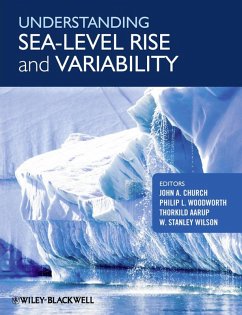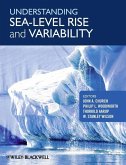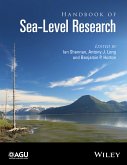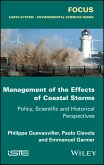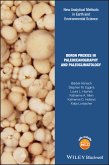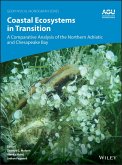Understanding Sea-level Rise and Variability (eBook, PDF)
Redaktion: Church, John A.; Wilson, W. Stanley; Aarup, Thorkild; Woodworth, Philip L.


Alle Infos zum eBook verschenken

Understanding Sea-level Rise and Variability (eBook, PDF)
Redaktion: Church, John A.; Wilson, W. Stanley; Aarup, Thorkild; Woodworth, Philip L.
- Format: PDF
- Merkliste
- Auf die Merkliste
- Bewerten Bewerten
- Teilen
- Produkt teilen
- Produkterinnerung
- Produkterinnerung

Hier können Sie sich einloggen

Bitte loggen Sie sich zunächst in Ihr Kundenkonto ein oder registrieren Sie sich bei bücher.de, um das eBook-Abo tolino select nutzen zu können.
Understanding Sea-Level Rise and Variability identifies the major impacts of sea-level rise, presents up-to-date assessments of past sea-level change, thoroughly explores all of the factors contributing to sea-level rise, and explores how sea-level extreme events might change. It identifies what is known in each area and what research and observations are required to reduce the uncertainties in our understanding of sea-level rise so that more reliable future projections can be made. A synthesis of findings provides a concise summary of past, present and future sea-level rise and its impacts on…mehr
- Geräte: PC
- mit Kopierschutz
- eBook Hilfe
- Größe: 16.94MB
![Understanding Sea-level Rise and Variability (eBook, ePUB) Understanding Sea-level Rise and Variability (eBook, ePUB)]() Understanding Sea-level Rise and Variability (eBook, ePUB)63,99 €
Understanding Sea-level Rise and Variability (eBook, ePUB)63,99 €![Handbook of Sea-Level Research (eBook, PDF) Handbook of Sea-Level Research (eBook, PDF)]() Handbook of Sea-Level Research (eBook, PDF)169,99 €
Handbook of Sea-Level Research (eBook, PDF)169,99 €![Instrumentation and Metrology in Oceanography (eBook, PDF) Instrumentation and Metrology in Oceanography (eBook, PDF)]() Marc Le MennInstrumentation and Metrology in Oceanography (eBook, PDF)160,99 €
Marc Le MennInstrumentation and Metrology in Oceanography (eBook, PDF)160,99 €![Oceans (eBook, PDF) Oceans (eBook, PDF)]() Guy JacquesOceans (eBook, PDF)139,99 €
Guy JacquesOceans (eBook, PDF)139,99 €![Management of the Effects of Coastal Storms (eBook, PDF) Management of the Effects of Coastal Storms (eBook, PDF)]() Philippe QuevauvillerManagement of the Effects of Coastal Storms (eBook, PDF)139,99 €
Philippe QuevauvillerManagement of the Effects of Coastal Storms (eBook, PDF)139,99 €![Boron Proxies in Paleoceanography and Paleoclimatology (eBook, PDF) Boron Proxies in Paleoceanography and Paleoclimatology (eBook, PDF)]() Bärbel HönischBoron Proxies in Paleoceanography and Paleoclimatology (eBook, PDF)106,99 €
Bärbel HönischBoron Proxies in Paleoceanography and Paleoclimatology (eBook, PDF)106,99 €![Coastal Ecosystems in Transition (eBook, PDF) Coastal Ecosystems in Transition (eBook, PDF)]() Coastal Ecosystems in Transition (eBook, PDF)174,99 €
Coastal Ecosystems in Transition (eBook, PDF)174,99 €-
-
-
Dieser Download kann aus rechtlichen Gründen nur mit Rechnungsadresse in A, B, BG, CY, CZ, D, DK, EW, E, FIN, F, GR, HR, H, IRL, I, LT, L, LR, M, NL, PL, P, R, S, SLO, SK ausgeliefert werden.
- Produktdetails
- Verlag: John Wiley & Sons
- Seitenzahl: 472
- Erscheinungstermin: 9. Februar 2010
- Englisch
- ISBN-13: 9781444323283
- Artikelnr.: 37342370
- Verlag: John Wiley & Sons
- Seitenzahl: 472
- Erscheinungstermin: 9. Februar 2010
- Englisch
- ISBN-13: 9781444323283
- Artikelnr.: 37342370
John A. Church (Centre for Australian Weather and Climate Research)
Thorkild Aarup (Intergovernmental Oceanographic Commission)
and W. Stanley Wilson (NOAA Satellite & Information Service). References. 2. Impacts of and Responses to Sea-Level Rise: Robert J. Nicholls (University of Southampton). Acknowledgments. References. 3. A First-Order Assessment of the Impact of Long-Term Trends in Extreme Sea Levels on Offshore Structures and Coastal Refineries: Ralph Rayner (Institute of Marine Engineering Science and Technology) and Bev MacKenzie (Institute of Marine Engineering Science and Technology). References. 4. Paleoenvironmental Records
Geophysical Modeling
and Reconstruction of Sea-Level Trends and Variability on Centennial and Longer Timescales: Kurt Lambeck (Australian National University)
Colin D. Woodroffe (University of Wollongong)
Fabrizio Antonioli (Ente per le Nuove Tecnologie
l'Energia e l'Ambiente
Rome)
Marco Anzidei (Istituto Nazionale di Geofisica e Vulcanologia
Rome)
W. Roland Gehrels (University of Plymouth)
Jacques Laborel (Université de la Méditerranée Aix-Marseille II)
and Alex J. Wright (Vrije Universiteit). Acknowledgments. References. 5. Modern Sea-Level-Change Estimates: Gary T. Mitchum (University of South Florida)
R. Steven Nerem (University of Colorado)
Mark A. Merrifield (University of Hawai'i)
and W. Roland Gehrels (University of Plymouth). Acknowledgments. References. 6. Ocean Temperature and Salinity Contributions to Global and Regional Sea-Level Change: John A. Church(Centre for Australian Weather and Climate Research)
Dean Roemmich (Scripps Institution of Oceanography)
Catia M. Domingues (Centre for Australian Weather and Climate Research)
Josh K. Willis (California Institute of Technology)
Neil J. White (Centre for Australian Weather and Climate Research)
John E. Gilson (Scripps Institution of Oceanography)
Detlef Stammer (University of Hamburg)
Armin Köhl (Institut für Meereskunde)
Don P. Chambers (University of South Florida)
Felix W. Landerer (Jet Propulsion Laboratory
Pasadena)
Jochem Marotzke (Max Planck Institute for Meteorology)
Jonathan M. Gregory (University of Reading)
Tatsuo Suzuki (Japan Agency for Marine-Earth Science and Technology)
Anny Cazenave (Laboratoire d'Etudes en Géophysique et Océanographie)
and Pierre-Yves Le Traon (IFREMER). Acknowledgments. References. 7. Cryospheric Contributions to Sea-Level Rise and Variability: Konrad Steffen (University of Colorado)
Robert H. Thomas (NASA/GSFC/Wallops Flight Facility)
Eric Rignot (California Institute of Technology)
J. Graham Cogley (Trent University)
Mark B. Dyurgerov (deceased)
Sarah C.B. Raper (Manchester Metropolitan University)
Philippe Huybrechts (Vrije Universiteit Brussel)
and Edward Hanna (University of Sheffield). References. 8. Terrestrial Water-Storage Contributions to Sea-Level Rise and Variability: P.C.D. (Chris) Milly (US Geological Survey)
Anny Cazenave (Laboratoire d'Etudes en Géophysique et Océanographie)
James S. Famiglietti (University of California
Irvine)
Vivien Gornitz (NASA/GISS and Columbia University)
Katia Laval (Laboratoire de Météorologie Dynamique)
Dennis P. Lettenmaier (University of Washington)
Dork L. Sahagian (Lehigh University)
John M. Wahr (University of Colorado)
and Clark R. Wilson (University of Texas). References. 9. Geodetic Observations and Global Reference Frame Contributions to Understanding Sea-Level Rise and Variability: Geoff Blewitt (University of Nevada)
Zuheir Altamimi (Institut Géographique National)
James Davis (Harvard-Smithsonian Center for Astrophysics)
Richard Gross (California Institute of Technology)
Chung-Yen Kuo (National Cheng Kung University)
Frank G. Lemoine (NASA Goddard Space Flight Center)
Angelyn W. Moore (California Institute of Technology)
Ruth E. Neilan (California Institute of Technology)
Hans-Peter Plag (University of Nevada)
Markus Rothacher (GeoForschungsZentrum)
C.K. Shum (Ohio State University)
Michael G. Sideris (University of Calgary)
Tilo Schöne (GeoForschungsZentrum)
Paul Tregoning (Australian National University)
and Susanna Zerbini (University of Bologna). Acknowledgments. References. 10. Surface Mass Loading on a Dynamic Earth: Complexity and Contamination in the Geodetic Analysis of Global Sea-Level Trends: Jerry X. Mitrovica (Harvard University)
Mark E. Tamisiea (Proudman Oceanographic Laboratory)
Erik R. Ivins (California Institute of Technology)
L.L.A. (Bert) Vermeersen (Delft University of Technology)
Glenn A. Milne (Department of Earth Sciences
University of Ottawa)
and Kurt Lambeck (Australian National University). Acknowledgments. References. 11. Past and Future Changes in Extreme Sea Levels and Waves: Jason A. Lowe (Met Office)
Philip L. Woodworth(Proudman Oceanographic Laboratory)
Tom Knutson (Geophysical Fluid Dynamics Laboratory)
Ruth E. McDonald (Met Office)
Kathleen L. McInnes (CSIRO)
Katja Woth (GKSS)
Hans von Storch (GKSS)
Judith Wolf (Proudman Oceanographic Laboratory)
Val Swail (Environment Canada)
Natacha B. Bernier (Dalhousie University)
Sergey Gulev (P.P. Shirshov Institute of Oceanology)
Kevin J. Horsburgh (Proudman Oceanographic Laboratory)
Alakkat S. Unnikrishnan (National Institute of Oceanography)
John R. Hunter (Antarctic Climate and Ecosystems Cooperative Research Centre)
and Ralf Weisse (GKSS). Acknowledgments. References. 12. Observing Systems Needed to Address Sea-Level Rise and Variability: W. Stanley Wilson(NOAA Satellite & Information Service)
Waleed Abdalati (University of Colorado)
Douglas Alsdorf (Ohio State University)
Jérôme Benveniste (European Space Agency)
Hans Bonekamp (European Organisation for the Exploitation of Meteorological Satellites)
J. Graham Cogley (Trent University)
Mark R. Drinkwater (European Space Agency)
Lee-Lueng Fu (Jet Propulsion Laboratory
Pasadena)
Richard Gross (California Institute of Technology)
Bruce J. Haines (California Institute of Technology)
D.E. Harrison (Pacific Marine Environmental Laboratory)
Gregory C. Johnson (Pacific Marine & Environmental Laboratory)
Michael Johnson (retired)
John L. LaBrecque (NASA)
Eric J. Lindstrom (NASA)
Mark A. Merrifield (University of Hawai'i)
Laury Miller (NOAA Laboratory for Satellite Altimetry)
Erricos C. Pavlis (NASA Goddard Space Flight Center)
Stephen Piotrowicz (NOAA)
Dean Roemmich (Scripps Institution of Oceanography)
Detlef Stammer (University of Hamburg)
Robert H. Thomas (NASA/GSFC/Wallops Flight Facility)
Eric Thouvenot (CNES)
and Philip L. Woodworth (Proudman Oceanographic Laboratory). References. 13. Sea-Level Rise and Variability: Synthesis and Outlook for the Future: John A. Church (Centre for Australian Weather and Climate Research)
Thorkild Aarup (Intergovernmental Oceanographic Commission)
Philip L. Woodworth (Proudman Oceanographic Laboratory)
W. Stanley Wilson (NOAA Satellite & Information Service)
Robert J. Nicholls (University of Southampton)
Ralph Rayner (Institute of Marine Engineering Science and Technology)
Kurt Lambeck (Australian National University)
Gary T. Mitchum (University of South Florida)
Konrad Steffen (University of Colorado)
Anny Cazenave (Laboratoire d'Etudes en Géophysique et Océanographie)
Geoff Blewitt (University of Nevada)
Jerry X. Mitrovica (Harvard University)
and Jason A. Lowe (Met Office). References. Index.
John A. Church (Centre for Australian Weather and Climate Research)
Thorkild Aarup (Intergovernmental Oceanographic Commission)
and W. Stanley Wilson (NOAA Satellite & Information Service). References. 2. Impacts of and Responses to Sea-Level Rise: Robert J. Nicholls (University of Southampton). Acknowledgments. References. 3. A First-Order Assessment of the Impact of Long-Term Trends in Extreme Sea Levels on Offshore Structures and Coastal Refineries: Ralph Rayner (Institute of Marine Engineering Science and Technology) and Bev MacKenzie (Institute of Marine Engineering Science and Technology). References. 4. Paleoenvironmental Records
Geophysical Modeling
and Reconstruction of Sea-Level Trends and Variability on Centennial and Longer Timescales: Kurt Lambeck (Australian National University)
Colin D. Woodroffe (University of Wollongong)
Fabrizio Antonioli (Ente per le Nuove Tecnologie
l'Energia e l'Ambiente
Rome)
Marco Anzidei (Istituto Nazionale di Geofisica e Vulcanologia
Rome)
W. Roland Gehrels (University of Plymouth)
Jacques Laborel (Université de la Méditerranée Aix-Marseille II)
and Alex J. Wright (Vrije Universiteit). Acknowledgments. References. 5. Modern Sea-Level-Change Estimates: Gary T. Mitchum (University of South Florida)
R. Steven Nerem (University of Colorado)
Mark A. Merrifield (University of Hawai'i)
and W. Roland Gehrels (University of Plymouth). Acknowledgments. References. 6. Ocean Temperature and Salinity Contributions to Global and Regional Sea-Level Change: John A. Church(Centre for Australian Weather and Climate Research)
Dean Roemmich (Scripps Institution of Oceanography)
Catia M. Domingues (Centre for Australian Weather and Climate Research)
Josh K. Willis (California Institute of Technology)
Neil J. White (Centre for Australian Weather and Climate Research)
John E. Gilson (Scripps Institution of Oceanography)
Detlef Stammer (University of Hamburg)
Armin Köhl (Institut für Meereskunde)
Don P. Chambers (University of South Florida)
Felix W. Landerer (Jet Propulsion Laboratory
Pasadena)
Jochem Marotzke (Max Planck Institute for Meteorology)
Jonathan M. Gregory (University of Reading)
Tatsuo Suzuki (Japan Agency for Marine-Earth Science and Technology)
Anny Cazenave (Laboratoire d'Etudes en Géophysique et Océanographie)
and Pierre-Yves Le Traon (IFREMER). Acknowledgments. References. 7. Cryospheric Contributions to Sea-Level Rise and Variability: Konrad Steffen (University of Colorado)
Robert H. Thomas (NASA/GSFC/Wallops Flight Facility)
Eric Rignot (California Institute of Technology)
J. Graham Cogley (Trent University)
Mark B. Dyurgerov (deceased)
Sarah C.B. Raper (Manchester Metropolitan University)
Philippe Huybrechts (Vrije Universiteit Brussel)
and Edward Hanna (University of Sheffield). References. 8. Terrestrial Water-Storage Contributions to Sea-Level Rise and Variability: P.C.D. (Chris) Milly (US Geological Survey)
Anny Cazenave (Laboratoire d'Etudes en Géophysique et Océanographie)
James S. Famiglietti (University of California
Irvine)
Vivien Gornitz (NASA/GISS and Columbia University)
Katia Laval (Laboratoire de Météorologie Dynamique)
Dennis P. Lettenmaier (University of Washington)
Dork L. Sahagian (Lehigh University)
John M. Wahr (University of Colorado)
and Clark R. Wilson (University of Texas). References. 9. Geodetic Observations and Global Reference Frame Contributions to Understanding Sea-Level Rise and Variability: Geoff Blewitt (University of Nevada)
Zuheir Altamimi (Institut Géographique National)
James Davis (Harvard-Smithsonian Center for Astrophysics)
Richard Gross (California Institute of Technology)
Chung-Yen Kuo (National Cheng Kung University)
Frank G. Lemoine (NASA Goddard Space Flight Center)
Angelyn W. Moore (California Institute of Technology)
Ruth E. Neilan (California Institute of Technology)
Hans-Peter Plag (University of Nevada)
Markus Rothacher (GeoForschungsZentrum)
C.K. Shum (Ohio State University)
Michael G. Sideris (University of Calgary)
Tilo Schöne (GeoForschungsZentrum)
Paul Tregoning (Australian National University)
and Susanna Zerbini (University of Bologna). Acknowledgments. References. 10. Surface Mass Loading on a Dynamic Earth: Complexity and Contamination in the Geodetic Analysis of Global Sea-Level Trends: Jerry X. Mitrovica (Harvard University)
Mark E. Tamisiea (Proudman Oceanographic Laboratory)
Erik R. Ivins (California Institute of Technology)
L.L.A. (Bert) Vermeersen (Delft University of Technology)
Glenn A. Milne (Department of Earth Sciences
University of Ottawa)
and Kurt Lambeck (Australian National University). Acknowledgments. References. 11. Past and Future Changes in Extreme Sea Levels and Waves: Jason A. Lowe (Met Office)
Philip L. Woodworth(Proudman Oceanographic Laboratory)
Tom Knutson (Geophysical Fluid Dynamics Laboratory)
Ruth E. McDonald (Met Office)
Kathleen L. McInnes (CSIRO)
Katja Woth (GKSS)
Hans von Storch (GKSS)
Judith Wolf (Proudman Oceanographic Laboratory)
Val Swail (Environment Canada)
Natacha B. Bernier (Dalhousie University)
Sergey Gulev (P.P. Shirshov Institute of Oceanology)
Kevin J. Horsburgh (Proudman Oceanographic Laboratory)
Alakkat S. Unnikrishnan (National Institute of Oceanography)
John R. Hunter (Antarctic Climate and Ecosystems Cooperative Research Centre)
and Ralf Weisse (GKSS). Acknowledgments. References. 12. Observing Systems Needed to Address Sea-Level Rise and Variability: W. Stanley Wilson(NOAA Satellite & Information Service)
Waleed Abdalati (University of Colorado)
Douglas Alsdorf (Ohio State University)
Jérôme Benveniste (European Space Agency)
Hans Bonekamp (European Organisation for the Exploitation of Meteorological Satellites)
J. Graham Cogley (Trent University)
Mark R. Drinkwater (European Space Agency)
Lee-Lueng Fu (Jet Propulsion Laboratory
Pasadena)
Richard Gross (California Institute of Technology)
Bruce J. Haines (California Institute of Technology)
D.E. Harrison (Pacific Marine Environmental Laboratory)
Gregory C. Johnson (Pacific Marine & Environmental Laboratory)
Michael Johnson (retired)
John L. LaBrecque (NASA)
Eric J. Lindstrom (NASA)
Mark A. Merrifield (University of Hawai'i)
Laury Miller (NOAA Laboratory for Satellite Altimetry)
Erricos C. Pavlis (NASA Goddard Space Flight Center)
Stephen Piotrowicz (NOAA)
Dean Roemmich (Scripps Institution of Oceanography)
Detlef Stammer (University of Hamburg)
Robert H. Thomas (NASA/GSFC/Wallops Flight Facility)
Eric Thouvenot (CNES)
and Philip L. Woodworth (Proudman Oceanographic Laboratory). References. 13. Sea-Level Rise and Variability: Synthesis and Outlook for the Future: John A. Church (Centre for Australian Weather and Climate Research)
Thorkild Aarup (Intergovernmental Oceanographic Commission)
Philip L. Woodworth (Proudman Oceanographic Laboratory)
W. Stanley Wilson (NOAA Satellite & Information Service)
Robert J. Nicholls (University of Southampton)
Ralph Rayner (Institute of Marine Engineering Science and Technology)
Kurt Lambeck (Australian National University)
Gary T. Mitchum (University of South Florida)
Konrad Steffen (University of Colorado)
Anny Cazenave (Laboratoire d'Etudes en Géophysique et Océanographie)
Geoff Blewitt (University of Nevada)
Jerry X. Mitrovica (Harvard University)
and Jason A. Lowe (Met Office). References. Index.
